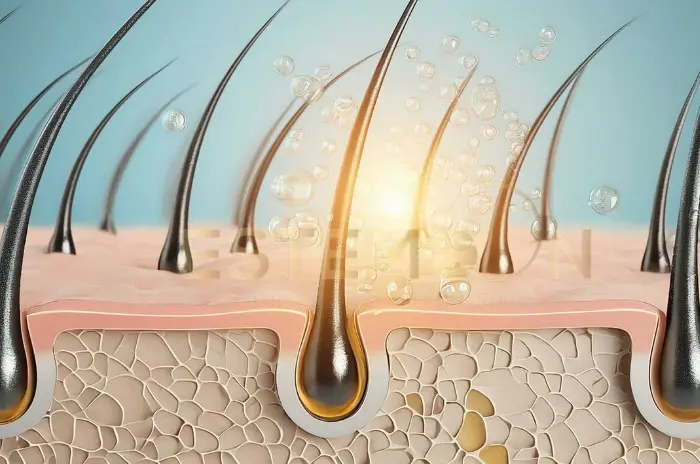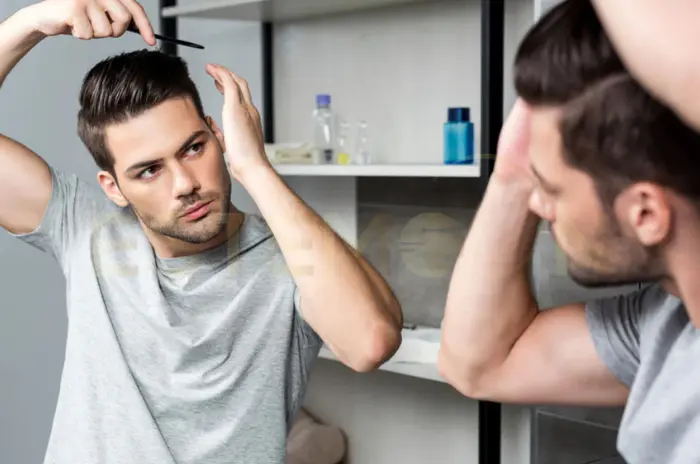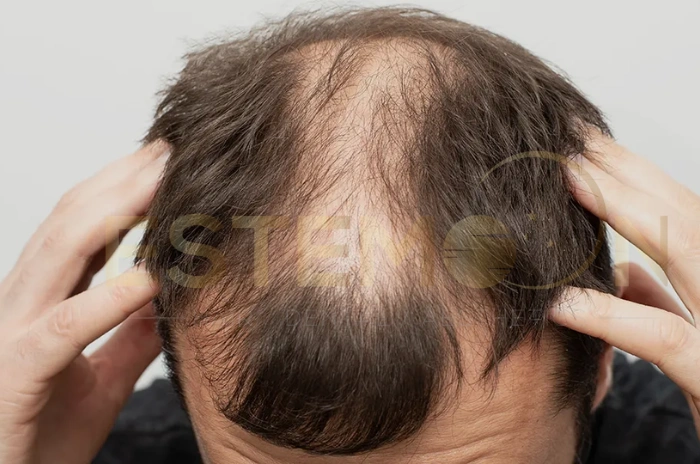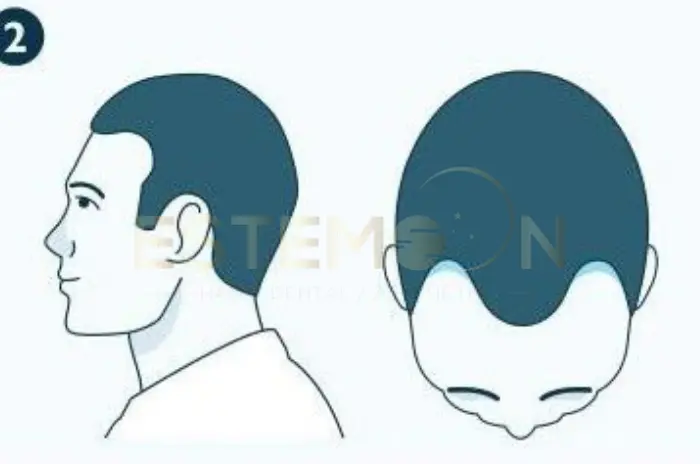Understanding hair follicle anatomy is essential for anyone interested in hair health, growth patterns, and potential treatment options. At Estemoon intermediary organization, we believe that comprehensive knowledge of hair follicle structure and function helps clients make informed decisions about hair care and treatment approaches.
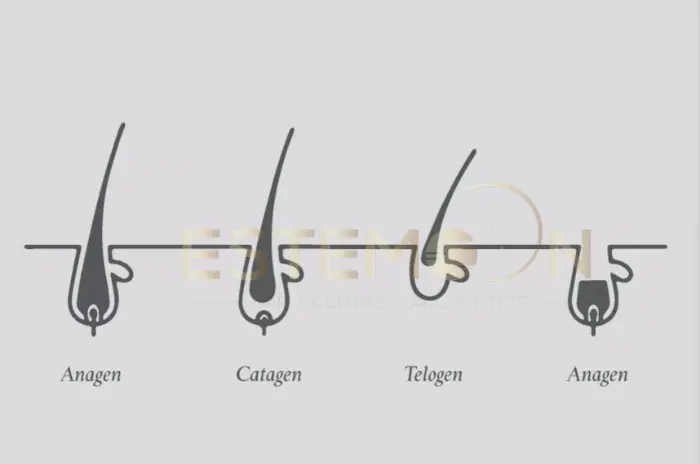
Understanding Basic Hair Follicle Anatomy
Hair follicles are complex, dynamic structures that extend deep into the skin layers, serving as miniature organs responsible for hair production. Each follicle represents a sophisticated biological system with multiple components working together to produce and maintain healthy hair growth.
The hair follicle consists of several distinct anatomical regions, each with specific functions and characteristics. Understanding these components provides insight into how hair grows, why problems occur, and how various treatments can be effective.
Primary follicle components:
- Hair shaft: The visible portion of hair extending above the skin surface
- Hair root: The portion of hair embedded within the follicle
- Hair bulb: The enlarged base containing actively dividing cells
- Dermal papilla: The vascular core providing nutrients and growth signals
- Root sheaths: Protective layers surrounding the developing hair
Anatomical layers from surface to depth:
- Epidermis connection and follicular opening
- Infundibulum (upper follicle portion)
- Isthmus (middle section with sebaceous gland attachment)
- Bulb region (lower portion with active cell division)
The follicle structure varies in size and depth depending on body location, with scalp follicles being among the largest and most complex. Each follicle operates independently while being influenced by systemic factors like hormones, nutrition, and overall health status.
Exploring the Hair Bulb and Dermal Papilla Structure
The hair bulb represents the most metabolically active portion of the hair follicle, functioning as the hair production center where rapid cell division and differentiation occur continuously during active growth phases.
Hair bulb composition:
- Matrix cells: Rapidly dividing cells that form the hair shaft and inner root sheath
- Melanocytes: Pigment-producing cells that determine hair color
- Stem cells: Reservoir cells that maintain follicle regeneration capacity
- Supporting structures: Basement membrane and connective tissue framework
The dermal papilla serves as the command center for hair follicle function, containing specialized cells that regulate growth cycles, hair thickness, and growth duration. This structure acts as a communication hub between the follicle and the body’s circulatory and nervous systems.
Dermal papilla functions:
- Nutrient and oxygen delivery through rich blood supply
- Growth factor production and distribution
- Hormonal signal reception and processing
- Waste product removal and detoxification
- Temperature regulation for optimal cell function
| Structure | Primary Function | Cell Types | Growth Phase Activity |
|---|---|---|---|
| Hair Matrix | Hair shaft production | Keratinocytes, melanocytes | High during anagen |
| Dermal Papilla | Growth regulation | Fibroblasts, endothelial cells | Active throughout cycle |
| Stem Cell Zone | Follicle regeneration | Multipotent stem cells | Active during transitions |
| Melanocyte Area | Pigment production | Melanocytes | Active during anagen |
The interaction between the hair bulb and dermal papilla determines individual hair characteristics including thickness, color, growth rate, and overall hair quality. Disruption of this relationship can lead to various hair disorders and growth abnormalities.
Functions of the Outer and Inner Root Sheaths
The root sheath system provides structural support, protection, and guidance for developing hair as it grows from the bulb toward the surface. These specialized layers ensure proper hair formation and protect the delicate growth process.
Inner Root Sheath (IRS) characteristics:
- Composition: Three distinct layers with different keratinization patterns
- Function: Molds and shapes the developing hair shaft
- Lifespan: Degrades as hair reaches the middle follicle portion
- Importance: Critical for proper hair texture and structure formation
Inner Root Sheath layers:
- Henle’s layer: Outermost IRS layer with early keratinization
- Huxley’s layer: Middle layer providing structural support
- Cuticle: Innermost layer interfacing directly with hair shaft
Outer Root Sheath (ORS) functions:
- Structural support: Maintains follicle shape and integrity
- Stem cell reservoir: Contains follicle regeneration cells
- Metabolic support: Provides nutrients and removes waste products
- Communication pathway: Facilitates signaling between follicle regions
Protective mechanisms:
- Physical barrier against external contaminants
- Chemical protection from environmental toxins
- Mechanical support during hair shaft formation
- Immune surveillance and inflammatory response coordination
The root sheath system works in coordination with sebaceous glands to provide lubrication and additional protection for emerging hair. Disruption of root sheath function can result in hair shaft abnormalities, breakage, and growth disorders.
The Three Phases of the Hair Growth Cycle
Hair growth follows a precisely regulated cyclical pattern consisting of three distinct phases, each with specific duration, cellular activity, and functional characteristics. Understanding this cycle is crucial for recognizing normal hair behavior and identifying potential problems.
Anagen Phase (Active Growth):
- Duration: 2-7 years for scalp hair
- Characteristics: Rapid cell division and hair shaft production
- Follicle activity: Maximum metabolic activity and nutrient demand
- Hair production: Continuous elongation at approximately 1cm per month
During anagen, the follicle reaches its maximum size and depth, with the dermal papilla fully engaged in growth regulation. Matrix cells divide rapidly, producing both the hair shaft and inner root sheath in a coordinated manner.
Catagen Phase (Transition):
- Duration: 2-3 weeks
- Characteristics: Growth cessation and follicle regression
- Cellular changes: Matrix cell death and dermal papilla separation
- Structural modifications: Follicle shortening and inner root sheath breakdown
Telogen Phase (Resting):
- Duration: 2-4 months
- Characteristics: Complete growth cessation and hair retention
- Follicle state: Shortened structure with club hair formation
- Preparation: Stem cell activation for next growth cycle
| Growth Phase | Duration | Activity Level | Hair Changes | Follicle Changes |
|---|---|---|---|---|
| Anagen | 2-7 years | High | Continuous growth | Full extension |
| Catagen | 2-3 weeks | Decreasing | Growth stops | Regression begins |
| Telogen | 2-4 months | Minimal | Hair retention | Shortened, resting |
| Exogen | Variable | None | Hair shedding | Preparation for new cycle |
Factors influencing cycle timing:
- Age and hormonal status
- Nutritional adequacy and health conditions
- Seasonal variations and environmental factors
- Genetic predisposition and ethnic background
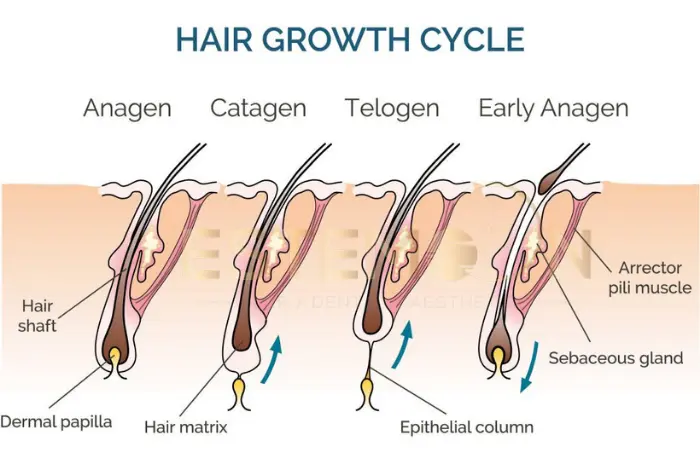
How Hair Shaft Formation and Keratinization Work
Hair shaft formation represents one of the most sophisticated keratinization processes in the human body, involving the transformation of living matrix cells into the highly organized, durable structure we recognize as hair.
Keratinization process stages:
- Cell division: Matrix cells multiply rapidly in the hair bulb
- Differentiation: Cells begin specializing into hair shaft components
- Protein synthesis: Keratin production increases dramatically
- Hardening: Progressive dehydration and cross-linking of proteins
Hair shaft structural components:
- Cuticle: Outer protective layer with overlapping scales
- Cortex: Middle layer providing strength and containing pigment
- Medulla: Central core present in thick hairs
The keratinization process involves the gradual replacement of cellular contents with keratin proteins, creating the strong, flexible structure that characterizes healthy hair. This transformation occurs as cells move upward from the bulb toward the surface.
Molecular changes during keratinization:
- Keratin gene activation and protein production
- Cross-linking formation between protein molecules
- Lipid synthesis for cuticle protection
- Melanin incorporation for color development
Quality factors affecting keratinization:
- Adequate protein and mineral availability
- Proper hormonal environment
- Optimal pH and cellular conditions
- Absence of toxic or inflammatory factors
Disruption of normal keratinization can result in weak, brittle, or structurally abnormal hair that is prone to breakage and damage.
Where Hair Follicles Are Located in the Skin
Hair follicles are distributed throughout the skin with varying density, size, and characteristics depending on body location and functional requirements. Understanding follicle distribution helps explain differences in hair growth patterns and treatment responses.
Skin layer positioning:
- Origin: Follicles develop in the epidermis during fetal development
- Extension: Mature follicles extend deep into the dermis and subcutaneous tissue
- Angulation: Follicles typically angle at 45-75 degrees to the skin surface
- Depth variation: Scalp follicles extend 4-7mm deep, while body hair follicles are typically 1-3mm
Anatomical distribution patterns:
- High-density areas: Scalp (100,000-150,000 follicles), face, pubic region
- Medium-density areas: Arms, legs, chest, back
- Low-density areas: Palms, soles, lips (follicle-free zones)
Follicle size variations:
- Terminal follicles: Large follicles producing thick, pigmented hair
- Vellus follicles: Small follicles producing fine, light-colored hair
- Intermediate follicles: Medium-sized with variable hair characteristics
Associated structures:
- Sebaceous glands attached to upper follicle portion
- Arrector pili muscles for hair elevation
- Nerve endings for sensation
- Blood vessel networks for nutrition
The relationship between follicles and surrounding skin structures creates a complex microenvironment that influences hair growth, appearance, and response to treatments.
Signs and Symptoms of Follicle Problems
Recognizing follicle dysfunction enables prompt intervention and better treatment outcomes.
Common dysfunction symptoms:
- Excessive shedding: More than 100-150 hairs lost daily
- Thinning areas: Reduced hair density in specific regions
- Texture changes: Coarser, finer, or more brittle hair
- Growth changes: Slower growing or shorter hair
Inflammatory conditions:
- Folliculitis with red, inflamed bumps
- Itching, burning, or tenderness
- Pustule formation and possible infection
- Scarring in severe cases
Hormonal-related symptoms:
- Pattern hair loss distribution
- Increased facial or body hair in women
- Sudden onset or rapid progression
- Associated acne or irregular periods
| Problem Type | Primary Symptoms | Associated Signs | Treatment Urgency |
|---|---|---|---|
| Androgenetic Alopecia | Gradual thinning, receding | Pattern-specific loss | Moderate |
| Alopecia Areata | Circular bald patches | Smooth, non-scarred skin | High |
| Folliculitis | Inflamed bumps, itching | Pustules, tenderness | Moderate to High |
| Telogen Effluvium | Diffuse shedding | Recent stress/illness | Low to Moderate |
When to seek evaluation:
- Sudden significant hair loss
- Painful or severely inflamed follicles
- Scarring or permanent damage
- Hair loss affecting quality of life
FAQ
What are the main parts of a hair follicle?
The main parts include the hair shaft (visible portion above skin), hair bulb (enlarged base with dividing cells), dermal papilla (vascular core providing nutrients), inner and outer root sheaths (protective layers), and hair matrix (rapidly dividing cells).
What are the three phases of hair growth?
The three phases are anagen (active growth lasting 2-7 years), catagen (transition lasting 2-3 weeks), and telogen (resting lasting 2-4 months). During anagen, hair grows continuously through rapid cell division.
Where are hair follicles located on the body?
Hair follicles are distributed throughout skin except palms, soles, and lips. They extend from epidermis deep into dermis and subcutaneous tissue. Scalp follicles are largest and deepest (4-7mm), while body hair follicles are 1-3mm deep.
What are signs of unhealthy hair follicles?
Signs include excessive daily shedding (over 100-150 hairs), progressive thinning or bald patches, changed hair texture becoming brittle, slower growth rates, and inflammatory symptoms like redness or itching.
Follow us on social media for updates, tips, and patient success stories:

